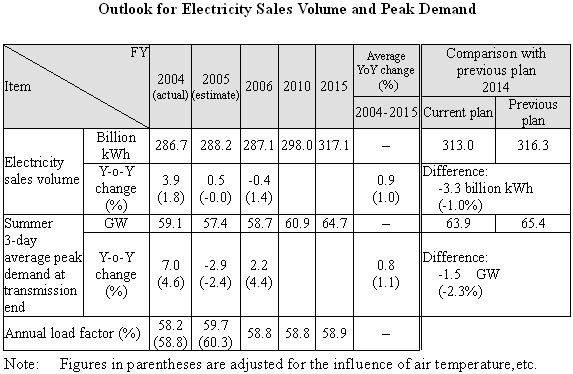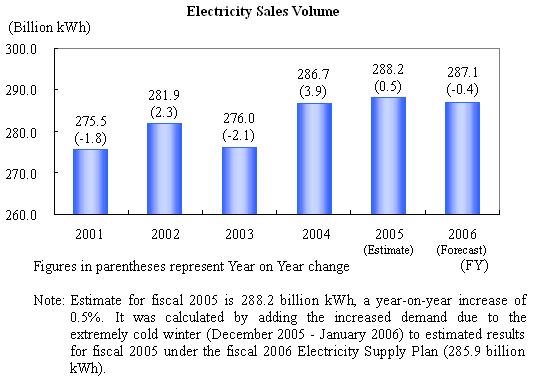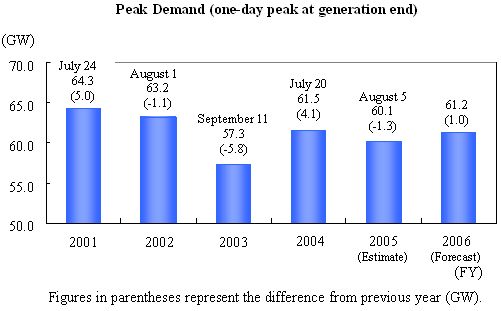Tokyo Electric Power Company (TEPCO) announced the establishment of
its fiscal 2006 Business Management Plan, setting out the issues and
main management targets that the TEPCO Group will address on a priority
basis over the next three years, with the aim of achieving further growth
and development and continuous improvement in corporate value.
In October 2004, TEPCO announced Management Vision 2010, the medium-term
management policy of the TEPCO Group for the period up to fiscal 2010.
The fiscal 2006 Business Management Plan serves as an action plan for working
toward the objectives of Management Vision 2010 over the coming three years
in line with the three Group Management Guidelines, "Win the Trust of
Society," "Compete and succeed," and "Foster People and Technologies," and
presents the targets to be achieved in the three-year period from fiscal 2006
through fiscal 2008.
The main points of the Fiscal 2006 Business Management Plan are as follows:
I. Win the Trust of Society
The entire TEPCO Group works together to provide a stable and secure supply
of energy, ensure safety and control quality, and strictly observe
corporate ethics, laws and regulations.
In response to the global warming, TEPCO also promotes safe, stable
operation of its nuclear power stations, improvement of thermal power
efficiency, increased use of renewable energy sources and utilizing the
Kyoto Mechanism in order to achieve the environmental contribution goals
set forth in Management Vision 2010 (reduce CO2 emission intensity to 20
percent below 1990 levels by fiscal 2010).
Outlook for Electric Power Demand
While the Japan's economy is expected to grow at a rate of around 1.5
percent per year for the medium to long term, the annual growth rate of
electric power demand is expected to average 1 percent (after adjustments
for air temperature) from fiscal 2004 to fiscal 2015 due to intensifying
competition from other energy producers and advances in energy conservation.
Although demand for cooling in summer mainly for residential and commercial
use is expected to increase, the average annual growth rate of peak demand
is expected to average 1.1 percent (after adjustments for air temperature)
from fiscal 2004 to fiscal 2015 due to factors such as promotion of thermal
storage air-conditioning units.
Despite an expected increase in industrial demand amid a gradual economic
recovery, electricity sales volume in fiscal 2006 is expected to decrease
0.4 percent year on year to 287.1 billion kWh due to a drop in demand for
cooling and heating following the hot summer and severe winter of fiscal
2005. This will be the first year-on-year decrease in three years.
Summer net peak demand (one-day peak at generation end) is expected to be
61.2 million kW, assuming normal summer temperatures.
 |
 |
 |
Power Generation Facility Plan
TEPCO will continue to steadily promote the best mix of power sources
centered on nuclear power based on its fundamental duty to ensure stable
supply and energy security, with overall consideration of factors such as
economics, operability and environmental compatibility.
II. Compete and Succeed
Amid intensifying competition, the entire TEPCO Group will work together to
achieve customer satisfaction by providing total solutions that meet their
increasingly diversified and sophisticated needs quickly and accurately.
The Group will also promote cost reduction in all fields.
Promote Marketing Activities Aimed at Customer Satisfaction
TEPCO aims to expand electricity sales volume by around 5 billion kWh over
the three year-period from fiscal 2006 through fiscal 2008, in line with
the Management Vision 2010 target of expanding cumulative electricity sales
volume by at least 10 billion kWh over the period from fiscal 2004 through
fiscal 2010.
1) Corporate and Large-scale Customers
.TEPCO will offer efficient energy systems that contribute to reducing
costs, energy consumption and CO2 emissions through an optimal combination
of various electricity rate options and electrical equipment and systems
tailored to each customer's current needs and plans.
.To meet diverse and sophisticated customer needs, TEPCO and its Group
companies will work together to become a one-stop source of total solution
services encompassing not only the supply of electricity, gas, steam and
other types of energy, but also planning, construction and maintenance of
facilities including telecommunications; environmental review;
off-balance-sheet transactions; business outsourcing; and other matters.
2) Household Customers
.TEPCO will encourage customers to adopt all-electric housing by promoting
its comfort, energy efficiency, environmental friendliness, dependability,
safety and superior economy through mass media advertising such as
television commercials and the Switch! campaign. In addition, TEPCO will
continue conducting marketing activities that target house planners,
builders and sellers, with the aim of increasing the ratio of all-electric
new housing to 22 percent (roughly equivalent to 95,000 homes) by fiscal
2008.
Promote Cost Reductions
TEPCO's goal under Management Vision 2010 is to improve operating efficiency
in fiscal 2010 by at least 20 percent compared with fiscal 2003. To achieve
this, TEPCO will mobilize the Group's overall strengths to reduce costs in all
fields in ways such as rationalizing facility configuration, operation and
maintenance and reviewing business processes, with facility safety and securing
quality as major premises.
Capital Expenditure Levels
TEPCO will undertake an average of around ¥620 billion in annual capital
expenditures over the three-year period from fiscal 2006 through fiscal 2008,
which is unchanged from levels in the previous plan.
Reduce the Number of Employees
TEPCO will reduce the number of employees to a total of 37,500 by the end of
fiscal 2008 through strict application of ongoing measures to increase
efficiency, including operational and organizational revisions and facility
automation.
Develop Profitable New Businesses to Ensure Growth Potential
Based on thorough selection and concentration, TEPCO will work to achieve
sustainable growth and development for the entire TEPCO Group by promoting
new businesses in the four areas of information and telecommunications,
energy and the environment, living environment and lifestyle-related and
overseas.
Operating Revenues and Operating Income Targets for Businesses Other than
Electric Power
Reflecting the comprehensive alliance with KDDI in the information and
telecommunications business, TEPCO has revised the numerical targets of
Management Vision 2010 (previously, operating revenues of at least ¥600
billion and operating income of at least ¥60 billion in businesses other
than electric power) as shown below. In conjunction with this, TEPCO aims to
achieve the following targets in its fiscal 2006 business management plan.
Specific Targets for Businesses Other than Electric Power
Under Management Vision 2010:
.Operating revenues of at least ¥300 billion
.Operating income of at least ¥50 billion
by fiscal 2010
Under the Fiscal 2006 Business Management Plan:
.Operating revenues of around ¥270 billion
.Operating income of around ¥40 billion
by fiscal 2008
Reference
Information and Telecommunications Business
.TEPCO will commence offering full-scale integrated fiber-to-the-home (FTTH)
services with KDDI.
.TEPCO will offer a variety of services that utilize high-speed PLC* and
other information and telecommunications technologies, including Internet,
energy management, home security and home electronics control services.
*High-speed PLC (Power Line Communication): High-speed telecommunications
using existing electrical distribution lines and household wiring
Gas-related Business
.TEPCO will promote development of LNG upstream divisions, the LNG carrier
business and LNG sales to strengthen its capabilities in supplying
liquefied natural gas (LNG) for thermal power generation and to expand
revenue potential.
.TEPCO will aggressively develop its gas supply business to enable it to
provide total solutions that meet the wide-ranging energy needs of its
customers.
Overseas Business
TEPCO aims to generate new growth and development by seeking new business
opportunities overseas. It will promote power generation projects, diverse
investments and a consulting business that employs TEPCO's technological
capabilities and expertise.
III. Foster People and Technologies
The entire TEPCO Group will work together to create enjoyable and satisfying
workplaces, strengthen and improve technologies and employee skills, and
develop technical strategies that support future growth.
IV. Management Targets
Income and Free Cash Flow
The entire TEPCO Group will work across all businesses to achieve higher
profitability by thoroughly improving efficiency and increasing operating
revenues through aggressive promotion of marketing activities aimed at
customer satisfaction. At the same time, it will work to secure free cash
flow by curbing capital expenditures and other cash outlays, and improve
asset efficiency in ways such as rationalizing facility operations and
reducing assets.
Through such efforts, TEPCO aims to achieve the following targets on a
three-year average basis over the period from fiscal 2006 through fiscal
2008.
Specific Targets
.Ordinary income (Consolidated) At least ¥380 billion
(Non-consolidated) At least ¥350 billion
.Return on assets (ROA) (Consolidated/Non-consolidated) At least 4%
.Free cash flow (Consolidated/Non-consolidated) At least ¥400 billion
Balance Sheet Improvement
Improving the balance sheet is a critical task for TEPCO in an operating
environment characterized by major changes, such as the increase in scope of
liberalization and intensifying competition among types of energy. TEPCO
will take measures to increase the shareholders' equity ratio, such as
selectively allocating free cash flow to reduce interest-bearing debt.
Specifically, TEPCO aims to achieve the following targets by the end of
fiscal 2008 in order to meet the numerical target of Management Vision 2010
of increasing the shareholders' equity ratio to at least 25 percent by
fiscal 2010.
Specific Targets
.Shareholders' equity ratio (Non-consolidated): at least 23% (as of the end
of fiscal 2008)
(Non-consolidated interest-bearing debt to be reduced by at least ¥700
billion over the period from fiscal 2006 through fiscal 2008)
Management Vision 2010 (Medium-Term Management Policy of the TEPCO Group)
Based on the TEPCO Group's management philosophy of contributing to better
lifestyles and environments by providing superior energy services, TEPCO
established three Group Management Guidelines under Management Vision 2010
- to win the trust of society, to compete and succeed, and to foster people
and technologies - and set five numerical targets in line with these
guidelines.